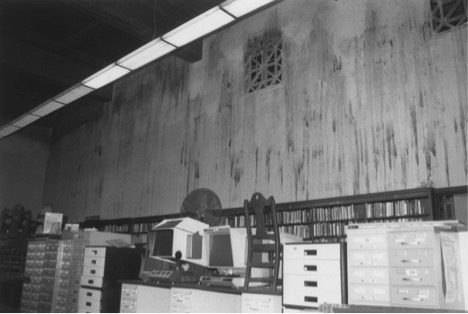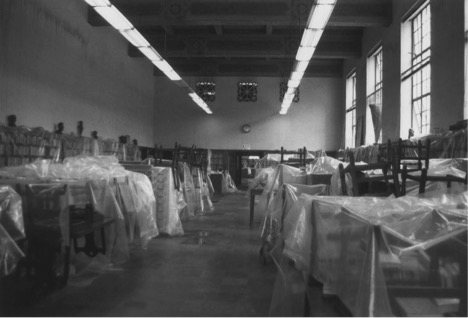This year, 2016, marks the 30th anniversary of the most catastrophic fire of a library building in the U.S. It occurred at our Central Library.
Fire and library experts had been warning for years that, should a fire occur, it would be catastrophic, destroy everything, both contents, and the structure.
Taking that as the dire warning it was, the city began preparations as early as 1978 to protect the building and in 1980 and 1981, installed alarm systems and committed the Los Angeles City Fire Department (LAFD) to do regular drills and practices to ensure that first responses would be swift and complete.
The planning paid off.
The library was open when an audio smoke detector alarm rang at 10:52 a.m. on April 29, 1986. Within five minutes, all 400 patrons and employees were out of the building. None were hurt. And the firefighters were there minutes later.
It was a battle against heat from the flames, steam from the water, and congested areas in the stacks, making movement awkward. Some firefighters salvaged bookcases with protective coverings as others fought the smoke and flames.
Although they were thoroughly prepared for this disaster, it took more than 350 firefighters and nearly every part of the fire department to squelch the fire. Some 60 fire fighting companies, one arson unit, nine paramedic rescue ambulances, three helicopters, four salvage companies, one squad, two emergency air units, a heavy utility company, and more than 40 support personnel and staff were involved.

Initially, firefighting efforts were focused in the northeast stacks. Then fire in the walls and the concrete and dense design of the building began to build up heat quickly.
The combination of the heat and the close quarters required that firefighter teams withdraw and be replaced every 15 minutes. In addition, super-heated steam from the open hoses pushed the firefighters back.
By 12:30 p.m., fire attack, ventilation efforts, and salvage work to protect the array of published works and other artifacts below the fire floor, were reaching a fevered pitch. Using sledgehammers and axes, the Ventilation Division breached the roof but were unable to open a hole large enough for effective ventilation. The heat continued to build inside from the fire. Some 34 city fire companies, 12 command and staff officers, one air ambulance, and seven rescue ambulances committed to the fire.
Six mutual aid companies from Los Angeles County were used to fill vacant stations until Fire Prevention personnel staff six reserve apparatus to relieve them. Five private ambulances and a Hospital Emergency Response Team from USC assisted the Medical Division in the care and treatment of injured firefighters.
By 1 p.m., fire was visible in the west windows of the Patent Room, then located on the west end of the building on the mezzanine level. The fire extended almost 300 feet on the second floor through the building, and from the northeast stack through the connecting hall into the northwest stack and out the window on the west end of the building.
Temperatures were estimated at higher than 2000 degrees F.
Master water streams were used to knock down the visible fire and to cool the building, dewatering helped to protect valuables, and the fire was finally contained. At that point, salvage efforts were stepped up.
Using jackhammers, the Ventilation Division opened up at least 18 holes in the building, breaking through more than six inches of concrete and steel reinforced material. As each hole was opened, large volumes of heat and smoke were released under pressure. The floors were so hot that when water was applied to cool the area, the water would actually boil. Then a large area of the 6th and 7th tiers collapsed inside of the northeast stack.
After seven hours and 38 minutes, a "knock down" was declared at 6:30 p.m. No fatalities of LAFD personnel were reported, but 50 were treated for injuries. Twenty-eight of these were transported to medical facilities and all recovered. There was only one minor civilian injury (he tripped over a water hose.)
Almost immediately, news of the fire mobilized armies of volunteers to help move damaged volumes offsite for freeze-drying. Ultimately, 400,000 volumes—20 percent of the library's holdings—were destroyed, with significant water and smoke damage done to the surviving works. But the preparation for a possible disaster of a $160 million loss was reduced to an actual loss of $2 million in damage to the structure and $20 million in damage to the contents. Out of over 1.2 million books that were in the library at the time of the fire, only 350,000 received any fire or water damage. The more important fact is that 85% of the total value of the structure and contents were saved. Today, the library’s holdings are 2.5 million items (books, music, movies, magazines, and books on tape or CDs, including more than 100,000 digital items.)

Two battalion chiefs and six fire companies remained on the scene for overhaul and investigation and to prevent the possible destruction of evidence and further damage to the library. An overhaul was limited to digging out hot spots and extinguishing them with small quantities of water. Hot spots continued to be found in the piles of burned books up to five days after the fire was extinguished.
A joint investigation by the LAFD Arson Unit and the Alcohol, Fire Arms, and Tobacco Department determined the fire was incendiary and began on the 5th tier of the northeast stack.
Details for this blog come from an official accounting of the firefighter response.
A short, but vivid, film captures some of the early hours of the fire and an eyewitness testimony by map librarian, Glen Creason.
An audio post on youtube.com posted by the L.A. City Clerk’s office provides the press conference held the following day. On the audio transmission, we hear not just the facts of the fire but the emotion, the fatigue, the hope and gratitude that our city’s mayor, Tom Bradley, and officials from the City Council and Fire Department expressed. Listen to the entire broadcast.
To see all of the Los Angeles Public Library's images of the fire and aftermath, use this pre-defined search in the Photo Collection.
Please join us for a docent-led tour of the Central Library.
